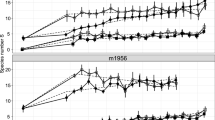Summary
This study examines the effects of soil disturbance by gophers on patterns of species abundance in an annual grassland community on serpentine soil. We assessed production, dispersal and storage of seed, germination, survivorship and growth of the most abundant species in undisturbed vegetation and on gopher mounds. Fewer seeds of the dominant species were dispersed onto gopher mounds due to the limited movement of seeds from within the closed vegetation. Species with taller flowering stalks were more likely to colonise gopher mounds. The timing of gopher disturbance in relation to the timing of seed fall determined which species could colonise mounds. Lower numbers of seeds falling onto gopher mounds resulted in lower seedling densities of several species compared with undisturbed areas. Survivorship of the commonest species differed between undisturbed areas and gopher mounds formed at different times of year. This resulted in characteristic spectra of species abundance on the different microhabitats, giving rise to distinct spatial patterning in the community. Plants growing on gopher mounds were generally larger and produced more seed than plants in undisturbed vegetation. We suggest that continued gopher disturbance is a factor allowing several species, including perennial grasses, to persist in this community.
Similar content being viewed by others
References
Bartolome JW (1979) Germination and seedling establishment in California annual grassland. J Ecol 67:273–281
Bartolome JW (1981) The ecological status of Stipa pulchra (Poaceae) in California. Madroño 28:172–184
Burtt BL (1977) Aspects of diversification in the capitulum. In: Heywood VH, Harborne JB, Turner BL (eds) The biology and chemistry of the Compositae. vol I. Academic Press, London New York, pp 41–59
Dirzo R, Sarukhan J (eds) (1984) Perspectives in plant, population biology. Sinauer Associates. Sunderland Massachusetts
Ellison L, Aldous CM (1952) Influence of pocket gophers on vegetation of subalpine grassland in central Utah. Ecology 33:177–186
Fitch HS, Bentley JR (1949) Use of California annual-plant forage by range rodents. Ecology 30:307–321
Foster MA, Stubbendieck J (1980) Effects of plains pocket gopher (Geomys bursarius) on rangeland. J Range Manage 33:74–78
Gettinger RD (1984) Energy and water metabolism of free-ranging pocket gophers Thomomys bottae. Ecology 65:740–757
Grubb PJ (1977) The maintenance of species-richness in plant communities: the importance of the regeneration niche. Biol Rev 52:107–145
Gulmon SL (1979) Competition and coexistence: three annual grass species. Am Midl Nat 101:403–416
Gulmon SL, Chiariello NR, Mooney HA, Chu CC (1983) Phenology and resource use in three co-occurring grassland annuals. Oecologia (Berlin) 58:33–42
Harper JL (1977) Population biology of plants. Academic Press, London New York
Hobbs RJ (1985) Harvester ant foraging and plant species distribution in annual grassland. Oecologia (Berlin) (in press)
Howard WE, Childs HE (1959) Ecology of pocket gophers with emphasis on Thomomys bottae Mewa. Hilgardia 29:277–358
Huston M (1979) A general hypothesis of species diversity. Am Nat 113:81–101
Law R (1981) The dynamics of a colonizing population of Poa annua. Ecology 62:1267–1277
Laycock WA (1958) The initial pattern of revegetation of pocket gopher mounds. Ecology 39:346–351
McEvoy PB (1984) Dormancy and dispersal of dimorphic achenes of tansy ragwort Senecio jacobaea L. (Compositae). Oecologia (Berlin) 61:160–168
McNaughton SJ (1968) Structure and function in California grasslands. Ecology 49:962–972
Maarel E van der (1984) Dynamics of plant populations from a synecological viewpoint. In: Dirzo R, Sarukhan J (eds) Perspectives in plant population ecology. Sinauer Associates. Sunderland Massachusetts, pp 66–82
Mallik AU, Hobbs RJ, Legg CJ (1984) Seed dynamics in Calluna — Arctostaphylos heath in Scotland. J Ecol 72:855–871
Mielke HW (1977) Mound building by pocket gophers (Geomyidae): their impact on soils and vegetation in North America. J Biogeog 4:171–180
Miller MA (1948) Seasonal trends in burrowing of pocket gophers (Thomomys). J Mammal 29:38–44
Platt WJ (1975) The colonisation and formation of equilibrium plant species associations on badger disturbances in a tallgrass prairie. Ecol Monogr 45:285–305
Proctor J, Whitten K (1971) A population of the valley pocket gopher (Thomomys bottae) on a serpentine soil. Am Midl Nat 78:176–179
Rabinowitz D, Rapp JK (1980) Seed rain in a North American tall grass prairie. J Appl Ecol 17:793–802
Schaal BA, Leverich WJ (1982) Survivorship patterns in an annual plant community. Oecologia (Berlin) 54:149–151
Sharitz RR, McCormick JF (1973) Population dynamics of two competing annual plant species. Ecology 54:723–739
Sheldon JC, Burrows FM (1973) The dispersal effectiveness of achene-pappus units of selected Compositae in steady winds with convection. New Phytol 72:665–675
Silvertown JW (1982) Introduction to plant population ecology. Longman, London New York
Singer MC, Ehrlich PR (1979) Population dynamics of the checkerspot butterfly Euphydryas editha. In: Halbach V, Jacobs J (eds) Population ecology. Fortschr Zool 25:29–52, Fischer, Stuttgart
Tilman D (1983) Plant succession and gopher disturbance along an experimental gradient. Oecologia (Berlin) 60:285–292
Turitzin SN (1981) Nutrient limitations to plant growth in a California serpentine grassland. Am Midl Nat 107:95–99
Watkinson AR (1978) The demography of a sand dune annual: Vulpia fasciculata III. The dispersal of seeds. J Ecol 66:483–493
Verkaar HJ, Schenkeveld AJ, Klashorst MP van der (1983) The ecology of short-lived forbs in chalk grasslands: dispersal of seeds. New Phytol 95:335–344
Young JA, Evans RA, Raguse CA, Larson JR (1981) Germinable seeds and periodicity of germination in annual grasslands. Hilgardia 49(2):1–37
Author information
Authors and Affiliations
Rights and permissions
About this article
Cite this article
Hobbs, R.J., Mooney, H.A. Community and population dynamics of serpentine grassland annuals in relation to gopher disturbance. Oecologia 67, 342–351 (1985). https://doi.org/10.1007/BF00384939
Received:
Issue Date:
DOI: https://doi.org/10.1007/BF00384939




